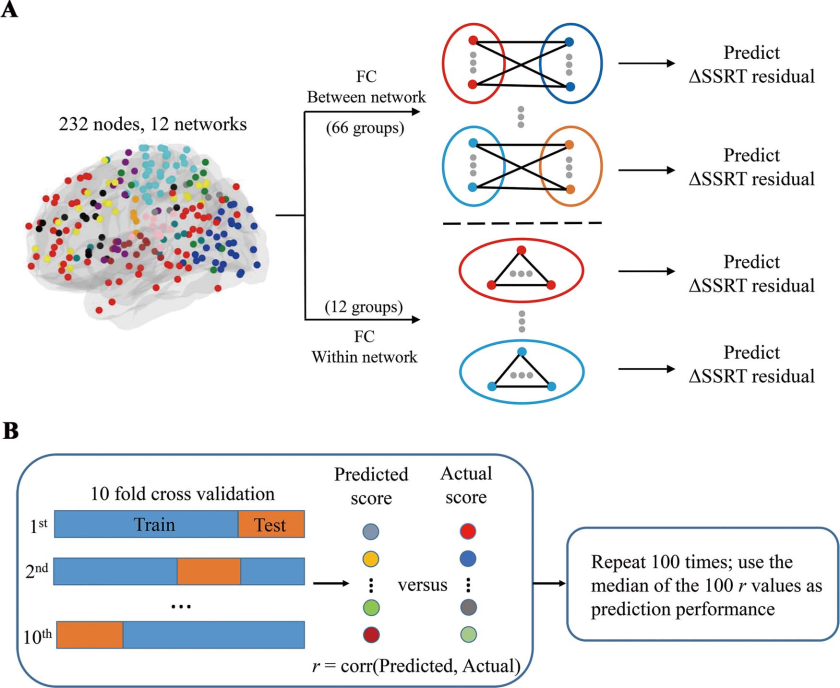Functional Connectivity Predicts Individual Development of Inhibitory Control during Adolescence
Haiyan Wang1,2, ... ..., Gunter Schumann 6,20,21,22,* and Tianzi Jiang 1,2,3,23,24,*
1Brainnetome Center and National Laboratory of Pattern Recognition, Institute of Automation, Chinese Academy of Sciences, Beijing 100190, China, 2School of Artificial Intelligence, University of Chinese Academy of Sciences, Beijing 100049, China, 3CAS Center for Excellence in Brain Science and Intelligence Technology, Institute of Automation, Chinese Academy of Sciences, Beijing 100190, China, ... ... 6Centre for Population Neuroscience and Precision Medicine (PONS), Institute of Psychiatry, Psychology & Neuroscience, SGDP centre,King’s College London, London SE5 8AF, United Kingdom, ... ... 20PONS Research Group, Department of Psychiatry and Psychotherapy, Campus Charite Mitte, Humboldt University, 10117 Berlin, Germany, 21Leibniz Institute for Neurobiology, 39118 Magdeburg, Germany, 22Institute for Science and Technology of Brain-inspired Intelligence (ISTBI), Fudan University, Shanghai 200433, China, 23The Clinical Hospital of Chengdu Brain Science Institute, MOE Key Lab for Neuroinformation, University of Electronic Science and Technology of China, Chengdu 625014, China and 24The Queensland Brain Institute, University of Queensland, Brisbane, Queensland 4072, Australia
Abstract
Derailment of inhibitory control (IC) underlies numerous psychiatric and behavioral disorders, many of which emerge during adolescence. Identifying reliable predictive biomarkers that place the adolescents at elevated risk for future IC deficits can help guide early interventions, yet the scarcity of longitudinal research has hindered the progress. Here, using a large-scale longitudinal dataset in which the same subjects performed a stop signal task during functional magnetic resonance imaging at ages 14 and 19, we tracked their IC development individually and tried to find the brain features predicting their development by constructing prediction models using 14-year-olds’ functional connections within a network or between a pair of networks. The participants had distinct between-subject trajectories in their IC development. Of the candidate connections used for prediction, ventral attention-subcortical network interconnections could predict the individual development of IC and formed a prediction model that generalized to previously unseen individuals. Furthermore, we found that connectivity between these two networks was related to substance abuse problems, an IC-deficit related problematic behavior, within 5 years. Our study reveals individual differences in IC development from mid- to late-adolescence and highlights the importance of ventral attention-subcortical network interconnections in predicting future IC development and substance abuse in adolescents.
Key words: adolescence, functional connectivity, inhibitory control, longitudinal prediction, stop signal task
 | Figure 1. Flowchart of SSRT residual prediction using brain functional connectivity profiles. (A) Definition of functional connectivity features. Brain nodes were defined by a predefined atlas with each node belonging to 1 of the 12 networks. Functional connections for each possible pair of ROIs between 2 networks or within 1 network were calculated, generating 66 groups of between-network and 12 groups of within-network connections. Each group of connections was separately used to predict the SSRT residual. (B) The 10-fold CV prediction process. For each group of connectivity features, a partial least squares regression analysis was used to learn their relationship with the SSRT residual. 10-fold CV was used to avoid overfitting; this was repeated 100 times to reduce the effect of data division. The median of the 100 r values and its corresponding P value (derived from 10 000 random permutations) was used to evaluate the prediction performance of each model. |
